
by KratomUSA | Jun 26, 2025 | Kratom
🧠 Kratom and ADHD: Can This Natural Herb Support Focus and Calm?
Attention Deficit Hyperactivity Disorder (ADHD) affects millions of children and adults worldwide. It can impact focus, memory, emotional regulation, and day-to-day productivity. While traditional treatments like Adderall and Ritalin are widely prescribed, some people are looking for natural alternatives that don’t involve harsh stimulants. One such alternative gaining attention. Let’s learn more about kratom and ADHD.
Native to Southeast Asia, kratom contains bioactive alkaloids that may interact with the brain’s dopamine, serotonin, and adrenergic systems. Some users say that certain kratom strains help them feel more focused, calm, and emotionally stable—symptoms commonly affected by ADHD.
This article explores what current research says about kratom and ADHD, including how it might be used responsibly as part of a natural wellness routine.
📌 Key Points: Kratom and ADHD
-
🌿 Kratom contains alkaloids that may influence focus, attention, and mood
-
🧪 Some strains are naturally stimulating, while others support calm and emotional regulation
-
🧠 Kratom may help with dopamine and norepinephrine activity, two key neurotransmitters linked to ADHD
-
⚠️ Kratom is not FDA-approved for treating ADHD, and more scientific studies are needed
-
✅ Responsible, moderate use and proper strain selection are essential for any potential benefit
🌿 How Might Kratom Affect ADHD Symptoms?
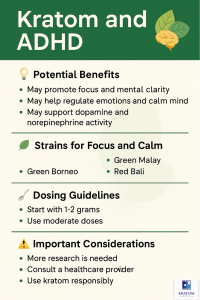 ADHD is characterized by dopamine and norepinephrine dysregulation—two neurotransmitters that play critical roles in attention, impulse control, and working memory.
ADHD is characterized by dopamine and norepinephrine dysregulation—two neurotransmitters that play critical roles in attention, impulse control, and working memory.
Kratom’s primary alkaloids, mitragynine and 7-hydroxymitragynine, act on opioid and adrenergic receptors in the brain. While kratom is not a stimulant in the same category as prescription ADHD medications, it may offer mild stimulant-like or calming effects, depending on the strain and dosage.
Key Effects Relevant to ADHD:
-
🧠 Enhanced cognitive clarity and task engagement (low doses, white/green strains)
-
💚 Calmer emotional state and reduced anxiety (moderate doses, red/green strains)
-
🌀 Possible support for dopamine pathways, which affect motivation and reward processing
🧪 What the Research Says
Although there are no clinical studies directly linking kratom to ADHD treatment, related findings provide useful insights.
📖 A 2017 user survey published in the Journal of Psychoactive Drugs reported that many users took kratom for focus, productivity, or emotional regulation, with self-reported benefits.
📖 A 2021 literature review in Frontiers in Pharmacology noted that mitragynine and its derivatives affect the central nervous system in dose-dependent ways—potentially offering stimulant or sedative effects.
These findings suggest that, although more controlled research is needed, kratom may influence some of the same systems targeted by ADHD medications.
💡 Best Kratom Strains for Focus and Emotional Balance
| Strain |
Primary Benefit |
Best Use Time |
| White Thai |
Focus, mental energy, productivity |
Morning/Afternoon |
| Green Malay |
Balanced mood + mild stimulation |
Late morning |
| Green Borneo |
Mental clarity + emotional balance |
Midday |
| Red Bali |
Calming, stress reduction |
Evening |
✅ White and green strains are typically best for improving focus
✅ Red strains may help users with hyperactivity or anxiety-related ADHD symptoms
🥄 Dosing Guidelines for Focus & ADHD Management
| Dosage |
Effect |
| 1–2 grams |
Light stimulation, sharper concentration |
| 2.5–4 grams |
Mental clarity, focus, stress relief |
| 5+ grams |
Sedating, not ideal for focus tasks |
💡 Start with a low dose and observe how your body reacts. ADHD symptoms can vary widely between individuals.
⚖️ Caution and Responsible Use
-
🚫 Kratom is not approved by the FDA for ADHD or any medical condition
-
🔁 Regular use can lead to tolerance or dependency if not carefully managed
-
🩺 Always consult a medical professional before using kratom as part of any self-treatment approach
🤔 FAQ: Kratom and ADHD
❓ Can kratom treat ADHD?
No. Kratom is not a medically recognized treatment for ADHD. However, some users report it helps manage symptoms like distractibility, anxiety, and lack of motivation.
❓ Which kratom strain is best for ADHD?
White Maeng Da and Green Malay are commonly used for focus and mental energy. Red strains may be better suited for hyperactive or emotionally reactive individuals.
❓ Can kratom replace Adderall or Ritalin?
Kratom may mimic some mild stimulant-like effects, but it is not a substitute for prescription ADHD medications. It may serve as a complementary aid for some people under professional supervision.
❓ Is kratom safe for teenagers with ADHD?
Kratom is not recommended for minors. Its long-term safety, especially in young people, has not been established.
❓ Are there any side effects?
Yes. Possible side effects include nausea, dizziness, dependency, and tolerance—especially at high doses or with daily use.
🌱 Final Thoughts: Can Kratom Support People With ADHD?
Kratom may offer mild focus-enhancing and calming effects that some users find helpful for managing ADHD symptoms. While it shouldn’t replace medical treatment or professional care, it could be a part of a broader strategy that includes lifestyle, diet, and natural support tools.
The key is to choose the right strain, use moderate doses, and stay informed. As interest in plant-based wellness grows, kratom may play a small but valuable role in supporting attention, productivity, and emotional regulation.
🛒 Explore lab-tested, focus-friendly kratom strains at KratomUSA.com — your trusted source for premium kratom powder and capsules.

by KratomUSA | Jun 25, 2025 | Kratom
😊 Kratom and Mood Support: Can This Natural Plant Help You Feel Better?
In a world where anxiety, depression, and daily stress weigh heavily on millions, more people are exploring natural options for emotional balance. Kratom, a tropical tree native to Southeast Asia, has caught attention not only for pain relief and energy but also for its potential to support mood and emotional wellness. Kratom’s mood-boosting potential comes from its unique alkaloids that interact with receptors in the brain related to serotonin, dopamine, and endorphin release. While kratom is not a cure for mood disorders, some users report it helps lift their mood, ease social anxiety, and promote motivation—especially when used in moderation. This article explores the science behind kratom and mood support, so you can make informed decisions about your health!
📌 Key Points: Kratom and Emotional Well-being
-
🌿 Kratom contains over 40 alkaloids that may support mood and stress relief
-
🧠 Some strains interact with dopamine and serotonin systems, possibly boosting mental clarity and calm
-
💚 Green and white vein strains may promote energy, motivation, and focus
-
🌙 Red strains may encourage relaxation and emotional balance
-
⚖️ Moderation, strain rotation, and self-awareness are key to avoiding tolerance
🌿 How Does Kratom Work in the Brain?
Kratom’s mood-related effects are largely due to alkaloids like:
-
Mitragynine – Acts on mu-opioid receptors, promoting a sense of well-being
-
7-hydroxymitragynine (7-HMG) – Potent, fast-acting alkaloid that enhances mood at low doses
-
Corynantheidine & Paynantheine – May interact with serotonin and dopamine pathways, influencing mood and mental clarity
🧪 A study published in the Journal of Psychoactive Drugs (2017) surveyed kratom users and found that 66% used kratom to improve mood or relieve anxiety, with many reporting noticeable improvement in overall emotional well-being.
🌞 Benefits of Kratom for Mood Support
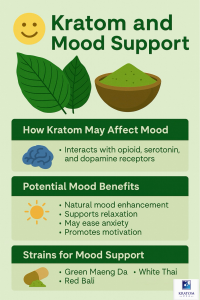 🔹 1. Natural Mood Enhancement
🔹 1. Natural Mood Enhancement
Many users report feeling more optimistic, motivated, and uplifted after taking kratom—especially in the morning or early afternoon.
Helpful strains:
-
Green Malay
-
White Borneo
-
Green Maeng Da
🔹 2. Social Anxiety and Confidence
Certain strains help promote calm and clarity, which may reduce social inhibition and improve interaction.
Helpful strains:
🔹 3. Relief from Mental Fatigue
Kratom may improve focus and cognitive drive, reducing feelings of burnout or mental fog.
Helpful strains:
-
Green Maeng da
-
Borneo Green Vein
🔹 4. Stress and Relaxation Support
Evening strains can promote a sense of ease, helping users wind down and reset emotionally.
Helpful strains:
💡 What Studies Say About Kratom and Mental Health
-
📖 A 2018 survey in Substance Use & Misuse found that most participants using kratom for mood management reported positive effects on anxiety, depression, and energy.
-
📖 A 2022 review in Frontiers in Psychiatry concluded that kratom may offer therapeutic value for mood disorders, although more clinical trials are needed.
While these results are promising, they also stress the need for:
🧪 How to Use Kratom Safely for Mood Support
| Dosage Level |
Typical Effect |
| 1–2 grams |
Mild stimulation, focus, motivation |
| 2–4 grams |
Balanced mood lift, calm energy |
| 4–6 grams |
Relaxation, anxiety relief, sedation |
✅ Start low and gradually increase if needed
✅ Rotate strains to avoid tolerance
✅ Avoid daily use to maintain effectiveness
💚 Strains Known for Mood Support
🤔 FAQ: Kratom and Mood Support
❓ Can kratom treat depression?
Kratom is not an FDA-approved treatment for depression. However, users report temporary relief from depressive symptoms, particularly with stimulating strains.
❓ Does kratom help with anxiety?
Many people use kratom to ease anxiety, particularly social anxiety. Red and green strains are most commonly chosen for their relaxing and balancing effects.
❓ What’s the best time of day to take kratom for mood?
For energy and motivation, take kratom in the morning. For stress relief or sleep support, take it later in the evening.
❓ Is kratom safe for long-term mood support?
Moderation is key. Using kratom occasionally and rotating strains can help reduce the risk of dependence and keep it effective.
❓ Is there scientific support for kratom’s mood effects?
While most data is anecdotal, multiple user surveys and observational studies suggest kratom may help with mood. More clinical trials are underway.
🌱 Final Thoughts: Can Kratom Help With Mood?
Kratom may offer natural mood support for those seeking relief from stress, low energy, or emotional fatigue. While it’s not a replacement for professional treatment, kratom could play a helpful role in boosting motivation, managing anxiety, and promoting emotional balance when used mindfully.
Always purchase kratom from lab-tested, reputable vendors and use responsibly.
🛒 Ready to explore premium kratom strains for mood support?
Visit KratomUSA.com for high-quality, lab-verified kratom capsules and powders trusted by thousands across the U.S.
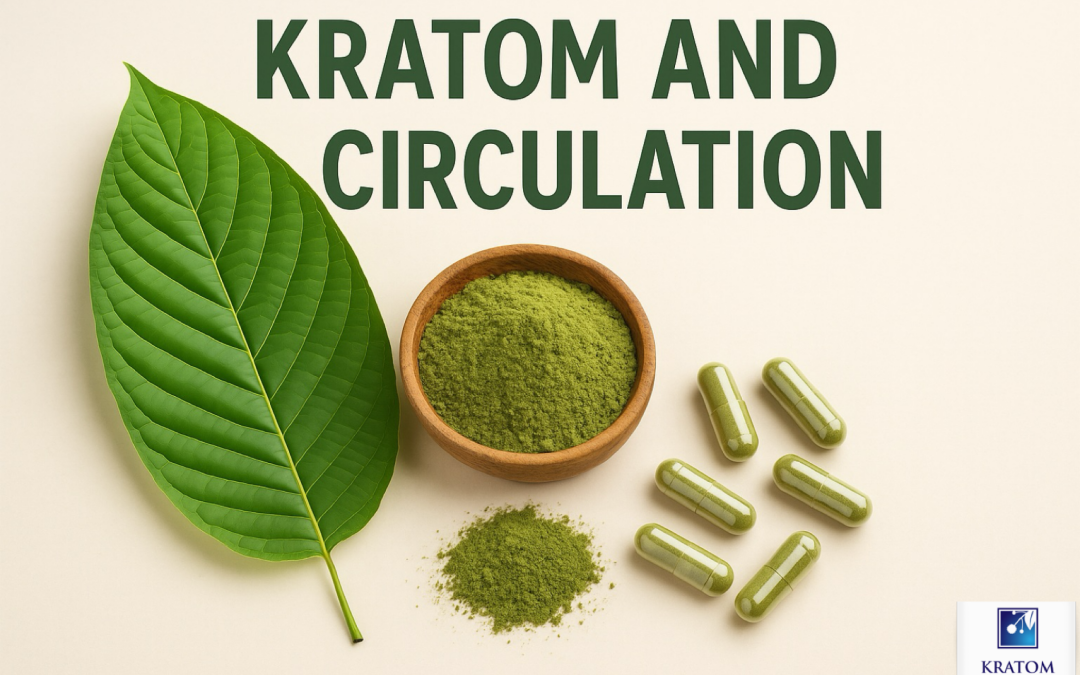
by KratomUSA | Jun 24, 2025 | Kratom
🫀 Kratom and Circulation: Can This Natural Herb Support Blood Flow?
Kratom (Mitragyna speciosa), a tropical plant native to Southeast Asia, is best known for its mood-enhancing and pain-relieving properties. But beyond its more familiar uses, some users and researchers have begun to ask: Can kratom improve blood circulation? While kratom isn’t typically marketed as a cardiovascular herb, anecdotal evidence and emerging insights suggest that certain alkaloids in kratom may influence blood pressure, heart rate, and overall circulation—both positively and negatively, depending on the dose, strain, and individual health status. This article explores the science behind kratom and circulation, its potential risks, and how it may fit into a natural wellness routine.
📌 Key Points: Kratom and Circulatory Health
-
🌿 Kratom contains alkaloids that affect the central nervous system and blood vessels
-
🧬 Some compounds may relax blood vessels, improving blood flow
-
🫁 Certain strains could reduce tension, stress, and inflammation, indirectly benefiting circulation
-
⚠️ High doses or long-term use may lead to changes in blood pressure or heart rate
-
✅ More clinical research is needed—but moderate, responsible use may support cardiovascular health
🧪 How Kratom Interacts with the Circulatory System
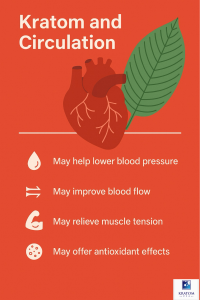 Kratom’s physiological effects are largely due to its active alkaloids, most notably:
Kratom’s physiological effects are largely due to its active alkaloids, most notably:
-
Mitragynine – The dominant alkaloid, known for stimulating effects at low doses and sedative effects at higher doses
-
7-hydroxymitragynine – A potent compound that affects mu-opioid receptors, with potential influence on blood pressure and vascular tone
-
Paynantheine and Speciogynine – Thought to promote smooth muscle relaxation, possibly contributing to vessel dilation
When kratom interacts with these systems, users may experience:
📖 Study Reference: A 2014 pharmacological review published in Drug and Alcohol Dependence noted that kratom’s alkaloids can have both stimulant and depressant effects, which may indirectly influence blood pressure and heart rate regulation.
🩸 Potential Circulatory Benefits of Kratom
🔹 1. Improved Blood Flow Through Vasodilation
Some kratom users report feeling a “flush” or warmth in the skin—likely due to blood vessel dilation. This may be tied to kratom’s action on smooth muscle and adrenergic receptors.
Relevant Strains: Red Maeng Da, Green Malay
Best Use: Low-to-moderate doses in the evening
🔹 2. Reduced Anxiety and Stress
High stress levels lead to vasoconstriction and poor circulation. Kratom’s calming properties may help reduce:
Relevant Strains: Red Bali, Red Borneo
🔹 3. Anti-Inflammatory Properties
Inflammation impairs circulation and is linked to cardiovascular disease. Kratom’s anti-inflammatory potential, especially in red strains, may contribute to vascular health.
📖 Study Reference: A 2020 study in Frontiers in Pharmacology explored kratom’s ability to reduce inflammation markers in animal models.
⚠️ Potential Circulatory Risks of Kratom
While some people experience improved circulation with kratom, others may face opposite effects, particularly with:
❗ Possible Risks Include:
-
Elevated heart rate (tachycardia) in stimulant doses (1–3 grams)
-
Blood pressure fluctuations (especially with white vein kratom)
-
Dependency, which can indirectly increase cardiovascular stress
📖 Note: A 2018 review in Journal of Clinical Psychopharmacology cautioned that kratom may cause cardiovascular side effects in sensitive individuals, particularly with excessive use.
🌿 Strains That May Support Circulation
| Strain |
Primary Alkaloids |
Circulation Effects |
| Green Malay |
Mitragynine, Speciogynine |
Balanced energy, anti-stress |
| Red Bali |
7-HMG, Paynantheine |
Muscle relaxation, calming effect |
| Red Borneo |
Mitragynine, Corynantheidine |
Anti-inflammatory, mood support |
| Red Maeng Da |
7-HMG, Speciogynine |
Vasodilation, tension relief |
💡 Pro Tip: Avoid white vein strains if you’re prone to high blood pressure—they can increase heart rate in sensitive users.
✅ How to Use Kratom for Circulatory Support
🥄 Dosage Guide
| Dosage |
Effect |
| 1–2 grams |
Light stimulation, increased focus |
| 2.5–4 grams |
Relaxation, improved blood flow |
| 5+ grams |
Sedative effects, possible blood pressure drop |
⏱️ Timing
💧 Hydration Matters
Kratom can mildly dehydrate the body. Drink plenty of water or electrolytes to support blood volume and flow.
🤔 FAQ: Kratom and Circulation
❓ Can kratom improve circulation?
Some users report better circulation and warmer extremities, likely due to kratom’s relaxing effects on blood vessels.
❓ Does kratom affect blood pressure?
Yes. Depending on dose and strain, it can either raise or lower blood pressure. Monitor your body’s response carefully.
❓ Is kratom safe for people with heart conditions?
Kratom should be used with caution. Speak with your doctor if you have hypertension, arrhythmia, or other cardiac issues.
❓ What’s the best kratom strain for healthy circulation?
Green Malay and Red Bali offer a good balance of relaxation and anti-inflammatory properties.
❓ Can kratom cause poor circulation?
In rare cases—especially with high doses or chronic use—it may contribute to vasoconstriction or elevated blood pressure.
🫀 Final Thoughts: Kratom and Circulatory Health
Kratom is not a cardiovascular supplement by design—but its muscle-relaxing, anti-inflammatory, and calming properties may offer indirect benefits for circulation and blood flow. As with any herb, it’s essential to listen to your body, avoid overuse, and use high-quality, lab-tested kratom.
If you’re seeking natural support for circulation, kratom may play a helpful role—especially as part of a larger wellness plan focused on stress reduction, hydration, and anti-inflammatory nutrition.
🛍️ Explore circulation-friendly kratom strains at KratomUSA.com — your trusted source for lab-tested, pure kratom powders and capsules.
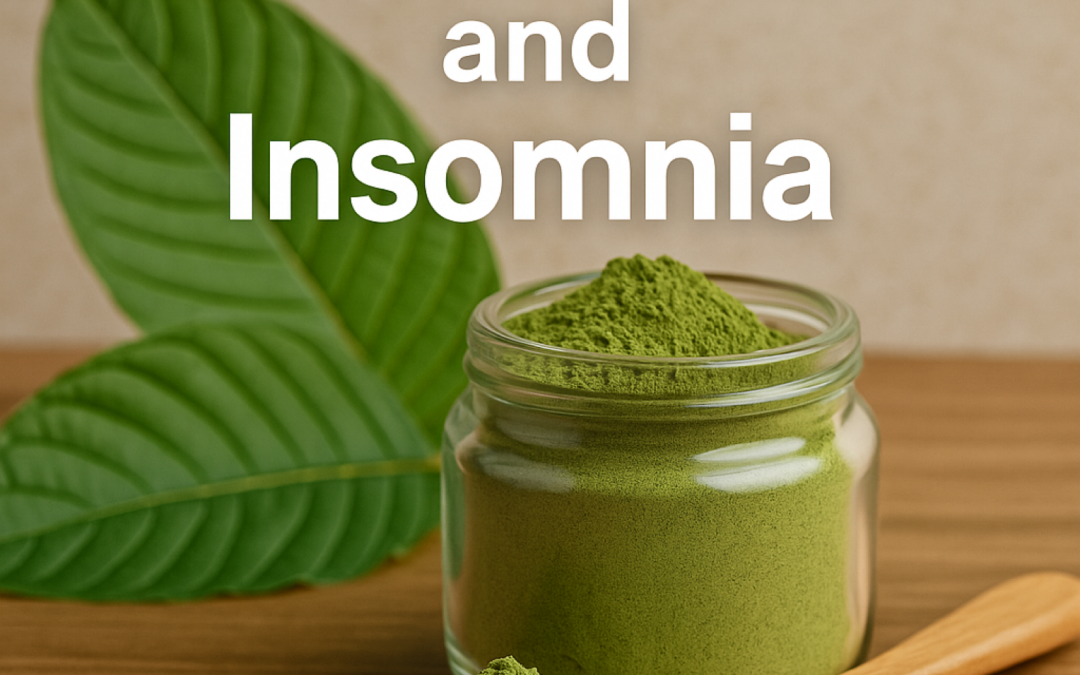
by KratomUSA | Jun 23, 2025 | Kratom
🌙 Kratom and Insomnia: Can This Natural Herb Help You Sleep Better?
If you’ve been tossing and turning at night, you’re not alone. Insomnia affects over 30% of adults in the U.S. at some point in their lives, often leading to fatigue, irritability, and poor mental clarity. While pharmaceutical sleep aids are available, many people are now looking toward natural alternatives—and one plant that’s gaining attention is kratom. Kratom (Mitragyna speciosa), a tropical tree native to Southeast Asia, has long been used for its calming, sedative-like effects—especially at higher doses. But can it really help with sleep problems like insomnia? Let’s take a deep dive into kratom and insomnia, how kratom works in the body, and whether it might be a safe, effective option for improving your sleep quality.
📌 Key Points: Kratom and Insomnia
-
🌿 Kratom is a natural herb with sedative properties at moderate to high doses
-
😴 Certain strains—especially red vein—can promote relaxation and deeper sleep
-
🧪 Research and user surveys show kratom may help people fall asleep faster and stay asleep longer
-
⚠️ It’s not without risks—overuse can lead to dependence or tolerance
-
✅ Choosing the right strain, dose, and timing is essential for safe and effective use
🌱 What Is Kratom and How Does It Work?
Kratom is made from the dried leaves of the Mitragyna speciosa tree. These leaves contain over 40 alkaloids, but two in particular—mitragynine and 7-hydroxymitragynine—play a major role in how kratom affects the brain and body.
These alkaloids interact with:
-
Mu-opioid receptors – leading to pain relief and relaxation
-
Dopamine and serotonin pathways – improving mood and calm
-
Adrenergic receptors – regulating alertness and stress response
📖 A 2017 study in Drug and Alcohol Dependence suggested kratom’s primary alkaloid, mitragynine, may have a dose-dependent sedative effect, especially at higher intake levels.
💤 Why People Use Kratom for Sleep Support
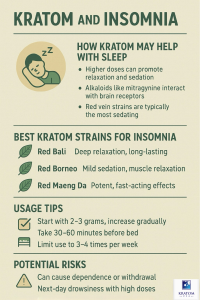 While kratom is often known for energy and focus at low doses, many users rely on it for the opposite effect at night. At moderate to high doses (4–6 grams), kratom—particularly red strains—can bring on:
While kratom is often known for energy and focus at low doses, many users rely on it for the opposite effect at night. At moderate to high doses (4–6 grams), kratom—particularly red strains—can bring on:
-
A sense of calm and contentment
-
Relief from physical discomfort
-
Muscle relaxation, aiding physical stillness
-
Sleepiness, making it easier to drift off
🌺 Best Kratom Strains for Insomnia
The type of kratom you use matters. Different strains have different effects based on alkaloid concentration.
| Strain |
Effects |
Ideal For |
| Red Bali |
Deep relaxation, long-lasting |
Chronic insomnia, stress-related sleep loss |
| Red Borneo |
Milder sedation, muscle relaxation |
Nighttime anxiety, light sleepers |
| Red Maeng Da |
Strong body effect, fast onset |
Restless legs, pain-induced insomnia |
💡 Avoid white and green vein strains at night—they’re more stimulating and may keep you awake.
🔬 What the Science Says
There are limited clinical trials on kratom and sleep, but emerging research and anecdotal evidence suggest a strong connection.
-
🧪 A 2025 survey in Journal of Psychoactive Drugs found that many kratom users took it to help with sleep, reporting increased sleep duration and improved quality
-
📚 A study from Frontiers in Psychiatry noted kratom’s ability to reduce anxiety, which often underlies insomnia
-
⚖️ However, the authors caution that long-term safety is still under investigation
🧪 How to Use Kratom for Insomnia Safely
✅ Ideal Dosage for Sleep Support
| Dose |
Effects |
| 2–3 grams |
Mild relaxation, not overly sedating |
| 4–5 grams |
Deeper relaxation, may support sleep |
| 6+ grams |
Strong sedation, not for beginners |
📌 Always start low and slow to avoid side effects like dizziness or nausea.
🕓 When to Take Kratom for Sleep
-
30–60 minutes before bed is ideal
-
Avoid using it during the day to prevent fatigue
-
Use no more than 3–4 nights per week to reduce tolerance
⚠️ Potential Side Effects and Risks
Kratom isn’t for everyone. Though it may help with sleep, it’s important to be aware of possible downsides:
-
Tolerance and dependence with frequent use
-
Grogginess the next morning, especially with high doses
-
Interaction risks with medications (e.g., benzos, SSRIs, or opioids)
-
Withdrawal symptoms if used daily for extended periods
To stay safe:
🤔 FAQ: Kratom and Sleep
❓ Can kratom cure insomnia?
Kratom is not a cure. It may help manage symptoms short-term but is not a substitute for addressing root causes like anxiety, poor sleep hygiene, or chronic stress.
❓ Which kratom is best for sleep?
Red Bali and Red Borneo are top choices due to their calming alkaloid profiles.
❓ Is kratom safe to take every night?
Not recommended. Daily use can lead to tolerance, meaning you need more to get the same effect. Limit use to a few nights per week.
❓ How long does it take to kick in?
Typically, 20–40 minutes. Effects last about 4–6 hours, depending on dose and metabolism.
❓ Can kratom make insomnia worse?
Yes—if you take too little, the stimulating effects can backfire. Stick to calming red strains and appropriate doses.
🌙 Final Thoughts: Can Kratom Help with Insomnia?
Kratom holds promise as a natural sleep aid—especially for people who struggle with pain, anxiety, or racing thoughts at night. While it may not be a long-term solution, when used responsibly, kratom can be a powerful part of your sleep toolkit.
The key? Start low, choose the right strain, avoid daily use, and listen to your body.
📦 Ready to try kratom for better sleep?
Explore high-quality, lab-tested red vein strains at KratomUSA.com — your trusted source for safe, natural sleep support.
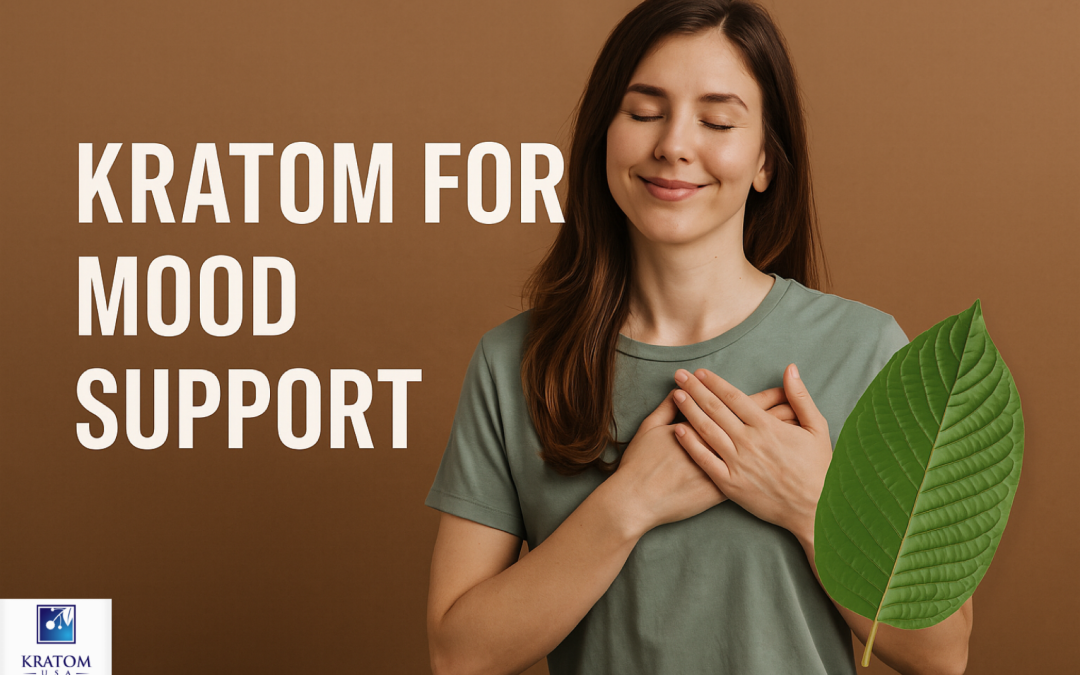
by KratomUSA | Jun 20, 2025 | Kratom
😊 Can This Natural Plant Boost Mental Clarity, Calm, and Motivation?
In an age where anxiety, low energy, and emotional burnout are common, more people are turning to natural remedies to uplift their mood and regain balance. One of the most talked-about botanicals in this space is kratom (Mitragyna speciosa)—a Southeast Asian tree known for its stimulating and soothing effects. But can kratom really help improve mood, motivation, and mental well-being? This article explores the science behind kratom for mood support, the best strains for emotional support, and how to use it safely for a more positive outlook on life.
📌 Key Points: Kratom for Mood Enhancement
-
🌱 Kratom contains alkaloids that affect dopamine, serotonin, and adrenergic receptors
-
😊 Low-to-moderate doses are linked to elevated mood, increased motivation, and reduced stress
-
🧘 Red and green strains can promote relaxation and emotional balance
-
🧪 Studies and surveys show kratom’s potential in helping with anxiety, mild depression, and mental fatigue
-
✅ Responsible use is key—strain rotation, dosage, and breaks prevent dependency
🧠 How Kratom Affects Mood
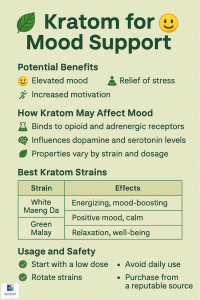 Kratom’s mood-altering effects come from its unique alkaloid profile, primarily:
Kratom’s mood-altering effects come from its unique alkaloid profile, primarily:
-
Mitragynine – A partial agonist at mu-opioid receptors and dopamine D2 receptors
-
7-Hydroxymitragynine – Potent in low quantities, may contribute to feelings of euphoria
-
Speciogynine and Paynantheine – May promote calmness and muscle relaxation
These alkaloids interact with brain pathways involved in pleasure, motivation, and anxiety, which is why users often report:
-
Enhanced outlook
-
Emotional resilience
-
Decreased irritability
📖 Study: A 2017 survey published in the Journal of Psychoactive Drugs found that 66% of kratom users took it to improve mood and many reported reduced anxiety and emotional stress.
😌 Benefits of Kratom for Mental and Emotional Wellness
🔹 1. Eases Stress and Anxiety
Kratom may help by:
-
Calming the central nervous system
-
Supporting dopamine and serotonin balance
-
Promoting “feel good” neurotransmitters in the brain
Best strains: Green Malay, Red Borneo
🔹 2. Uplifts Mood and Motivation
Users often report:
-
Increased confidence
-
Better social engagement
-
Reduced mental fatigue
Best strains: White Thai, Green Maeng Da
🔹 3. Helps with Mild Depression
Though not a treatment for clinical depression, kratom may provide temporary relief from:
-
Lack of motivation
-
Brain fog
-
Low energy or mood dips
📖 Study: In a 2018 Substance Use & Misuse report, many kratom users reported emotional improvement and reduced reliance on pharmaceutical antidepressants.
🍃 Best Kratom Strains for Mood Support
| Strain Type |
Strain Examples |
Mood Effects |
| White Vein |
White Thai, White Maeng Da |
Uplifting, energizing, focused |
| Green Vein |
Green Malay, Green Borneo |
Balanced, stress-reducing, mood stabilizing |
| Red Vein |
Red Bali, Red Borneo |
Calming, grounding, mild euphoria |
💡 Pro tip: Combine green and red strains for mood support without overstimulation.
🧪 How to Use Kratom Safely for Mood Support
✅ Dosing Guidelines
| Dose |
Effect |
| 1–2 grams |
Gentle mood lift, focus |
| 2.5–4 grams |
Euphoria, stress relief, clarity |
| 5+ grams |
Sedation, emotional detachment (not ideal for daytime use) |
-
Always start low and observe how you feel
-
Avoid daily use; try 2–4 times per week
-
Rotate strains to avoid building tolerance
⚠️ Safety Tips
-
Avoid mixing kratom with alcohol or prescription antidepressants
-
Stay hydrated—kratom may mildly dehydrate
-
Buy from GMP-compliant, lab-tested vendors like Kratom USA
🤔 FAQ: Kratom and Mood Support
❓ Can kratom replace antidepressants or anti-anxiety meds?
No. While many people report mood enhancement, kratom is not FDA-approved or clinically tested as a replacement for prescription medications.
❓ How quickly does kratom work for mood?
Most users feel a shift in 20–40 minutes after taking it. Effects can last 4–6 hours, depending on strain and dose.
❓ Which strain is best for depression?
Green Malay and White Maeng Da are commonly chosen for energy and emotional balance.
❓ Can kratom worsen mood?
Yes—especially at high doses or with chronic use. Overuse may lead to irritability, brain fog, or withdrawal symptoms.
❓ Is kratom addictive?
It can become habit-forming if used daily or at high doses. To avoid dependency, stick to intermittent use with regular breaks.
🌿 Final Thoughts: Can Kratom Help with Mood?
Kratom shows promise as a natural mood enhancer, especially for those seeking plant-based support for stress, energy, and emotional resilience. When used responsibly, certain kratom strains may offer a powerful boost to your mental well-being—without the side effects of conventional stimulants or sedatives.
As with any supplement, education, moderation, and quality are key.
📦 Looking for mood-supporting kratom strains?
Explore lab-tested green and white kratom powders at KratomUSA.com for natural clarity, calm, and confidence.
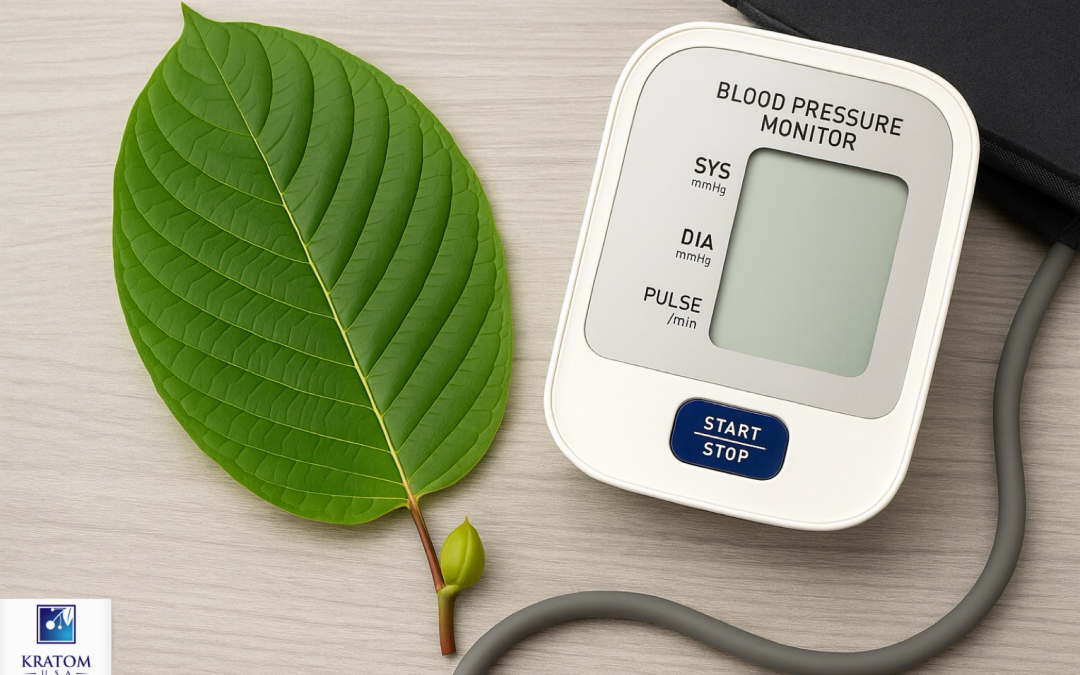
by KratomUSA | Jun 20, 2025 | Kratom
❤️ Kratom and Blood Pressure: What You Need to Know
Can Kratom Raise or Lower Your Blood Pressure? A Science-Based Look
Kratom (Mitragyna speciosa), a tropical herb native to Southeast Asia, is increasingly used for pain relief, energy, anxiety, and natural wellness. But for those with cardiovascular conditions or concerns about hypertension, a common question arises:
👉 Can kratom affect blood pressure?
In this article, we’ll explore how kratom interacts with the body’s cardiovascular system, what studies say about kratom’s effects on blood pressure, and how to use it safely—especially if you have pre-existing heart conditions or hypertension.
📌 Key Points: Kratom and Blood Pressure
-
🧪 Kratom’s alkaloids can influence blood pressure, heart rate, and vascular tone
-
⬆️ High doses may cause temporary increases in blood pressure or heart palpitations
-
⬇️ Low-to-moderate doses may relax blood vessels, especially with red strains
-
💊 Certain medications may interact with kratom’s cardiovascular effects
-
✅ Always consult a healthcare provider before using kratom if you have high blood pressure or heart issues
🧬 How Kratom Works in the Body
Kratom leaves contain over 40 bioactive alkaloids, the most studied being:
-
Mitragynine – Acts as a partial agonist on mu-opioid receptors, contributing to analgesia and sedation
-
7-Hydroxymitragynine – Potent pain reliever and central nervous system depressant
-
Speciogynine, Paynantheine, and Corynantheidine – May influence smooth muscle relaxation, which includes vascular muscles
These compounds not only affect mood and pain, but also interact with the autonomic nervous system, which regulates blood pressure, heart rate, and vascular constriction.
🔍 What Does the Research Say?
There is limited but growing research on kratom’s cardiovascular effects. Key findings include:
🩺 Mild Elevation in Blood Pressure and Heart Rate
-
A 2018 study published in Clinical Toxicology found that high doses of kratom may elevate blood pressure and heart rate, especially in stimulant-like strains or extracts
-
This is likely due to kratom’s action on adrenergic receptors, which are the same receptors activated by stimulants like caffeine and ephedrine
😌 Relaxation and Vasodilation at Low Doses
-
Anecdotal reports and animal studies suggest that red vein strains, which are higher in speciogynine, may relax smooth muscle, potentially supporting mild blood pressure reduction in some users
-
However, this effect is not consistent or predictable enough for kratom to be considered a treatment for hypertension
📖 Case Reports & Clinical Surveys
-
In a 2019 report in the Journal of Psychoactive Drugs, most kratom users did not experience dangerous cardiovascular side effects at typical doses (2–5 grams)
-
That said, individual responses vary widely, and risks may increase with pre-existing conditions or poly-drug use
⚠️ Kratom and Hypertension: Who Should Be Cautious?
Kratom’s potential to raise or lower blood pressure depends on:
-
Dose – Higher doses more likely to raise blood pressure
-
Strain – White strains may stimulate the nervous system; red strains may relax it
-
Individual factors – Existing heart disease, medications, hydration levels, etc.
❌ Avoid kratom or proceed with caution if you:
-
Have uncontrolled hypertension
-
Use beta-blockers, ACE inhibitors, or diuretics
-
Have a history of arrhythmias or stroke
-
Use stimulants, caffeine, or other vasoconstrictors
🌿 Best Kratom Strains for Blood Pressure Sensitivity
If you’re curious about trying kratom but want to avoid blood pressure spikes, these strains are typically considered milder and more relaxing:
| Strain |
Effects |
Blood Pressure Consideration |
| Red Bali |
Relaxation, mild sedation |
May promote vasodilation |
| Red Borneo |
Pain relief, calming |
Often used for stress reduction |
| Green Malay |
Balanced energy/mood |
Milder cardiovascular effects |
| Avoid: White Maeng Da, White Thai |
Stimulant-like; may elevate BP |
|
🧪 Safe Use Guidelines for Blood Pressure Management
✅ General Tips
-
Start with a low dose (1–2 grams)
-
Avoid extracts or enhanced kratom
-
Stay hydrated—dehydration can raise blood pressure
-
Never combine kratom with caffeine, nicotine, or stimulants
-
Monitor your blood pressure regularly if you’re sensitive
🕒 Dosage Chart
| Dose |
Effect |
Risk for BP |
| 1–2g |
Focus, mild mood lift |
Low |
| 2.5–4g |
Moderate pain relief, relaxation |
Medium |
| 5g+ |
Sedation, potential dizziness or elevated heart rate |
Higher risk |
🤔 FAQ: Kratom and Blood Pressure
❓ Can kratom lower blood pressure?
Possibly at low doses with sedating strains, but it’s not reliable or consistent enough to be used for hypertension.
❓ Can kratom raise blood pressure?
Yes—especially at high doses or with white vein strains. Effects vary person to person.
❓ What are the symptoms of kratom-related blood pressure issues?
❓ Is it safe to take kratom with blood pressure medication?
No. Kratom may interact with medications like beta-blockers, calcium channel blockers, or diuretics. Always talk to your doctor first.
❓ Should I take kratom if I have high blood pressure?
Not without medical approval. While some users report no issues, the risks are not well understood, and kratom can be unpredictable in sensitive individuals.
❤️ Final Thoughts: Kratom and Cardiovascular Health
Kratom can impact blood pressure through its effects on the nervous system and blood vessels. While some users experience relaxation and vasodilation, others—especially at higher doses—may notice increased heart rate or elevated blood pressure.
If you have any cardiovascular concerns, it’s essential to approach kratom with caution, start low, and consult your physician before use.
📦 Looking for lab-tested, red vein kratom strains with a mild cardiovascular profile?
Visit KratomUSA.com to explore natural options designed for pain relief and relaxation—without added stimulants.

 ADHD is characterized by dopamine and norepinephrine dysregulation—two neurotransmitters that play critical roles in attention, impulse control, and working memory.
ADHD is characterized by dopamine and norepinephrine dysregulation—two neurotransmitters that play critical roles in attention, impulse control, and working memory.


 🔹 1. Natural Mood Enhancement
🔹 1. Natural Mood Enhancement
 Kratom’s physiological effects are largely due to its
Kratom’s physiological effects are largely due to its 
 While kratom is often known for energy and focus at low doses, many users rely on it for the opposite effect at night. At moderate to high doses (4–6 grams), kratom—particularly red strains—can bring on:
While kratom is often known for energy and focus at low doses, many users rely on it for the opposite effect at night. At moderate to high doses (4–6 grams), kratom—particularly red strains—can bring on:
 Kratom’s
Kratom’s 